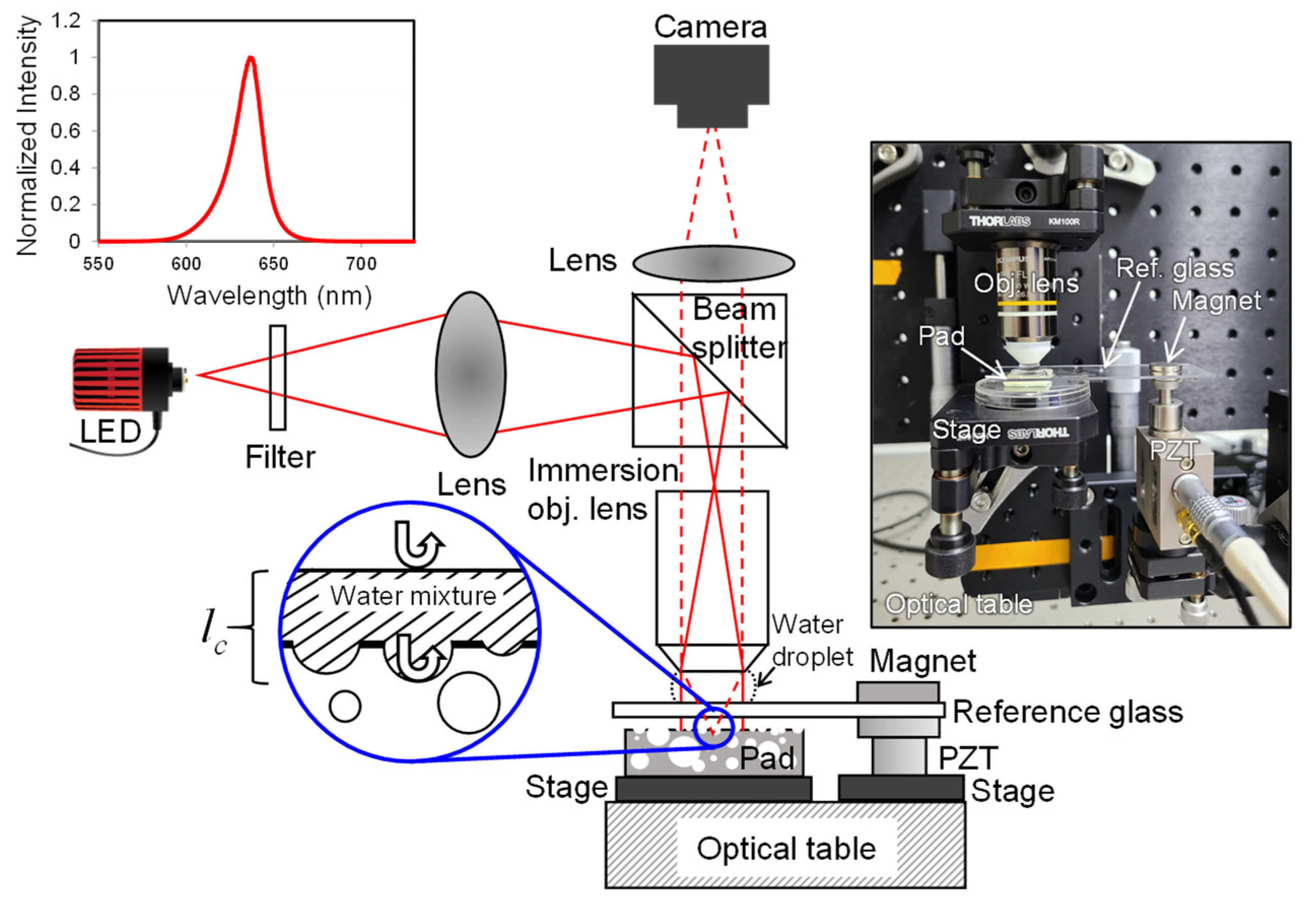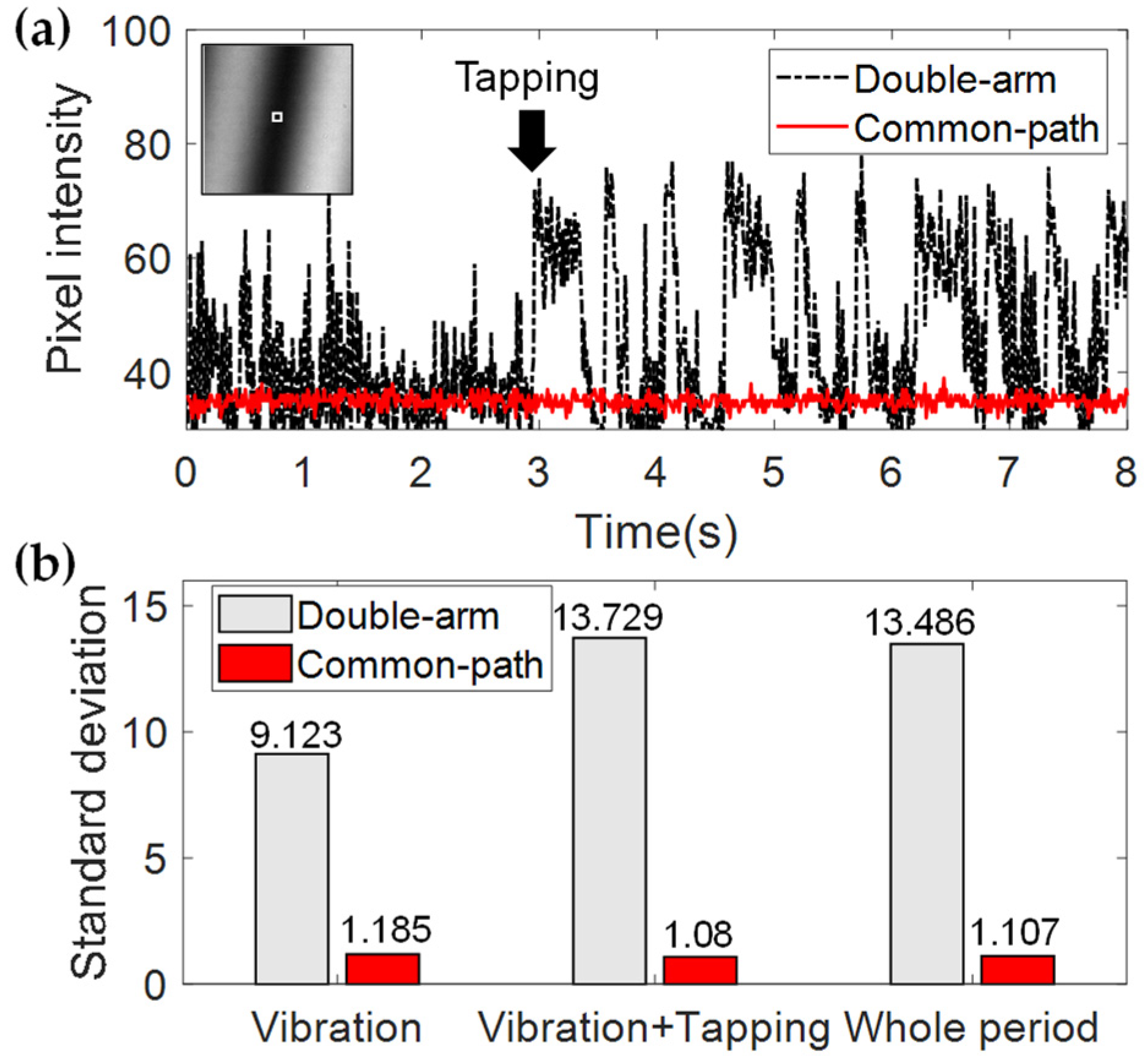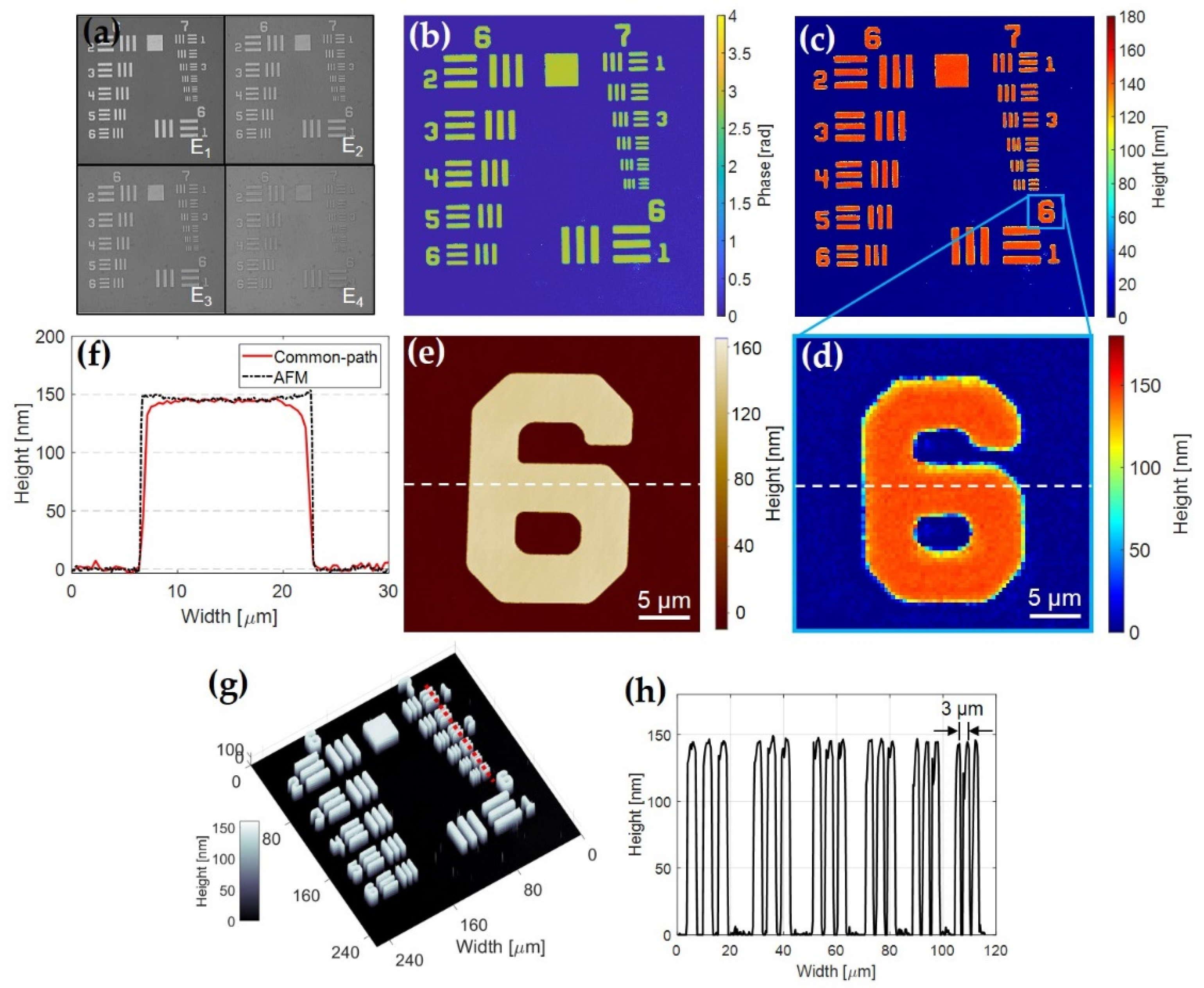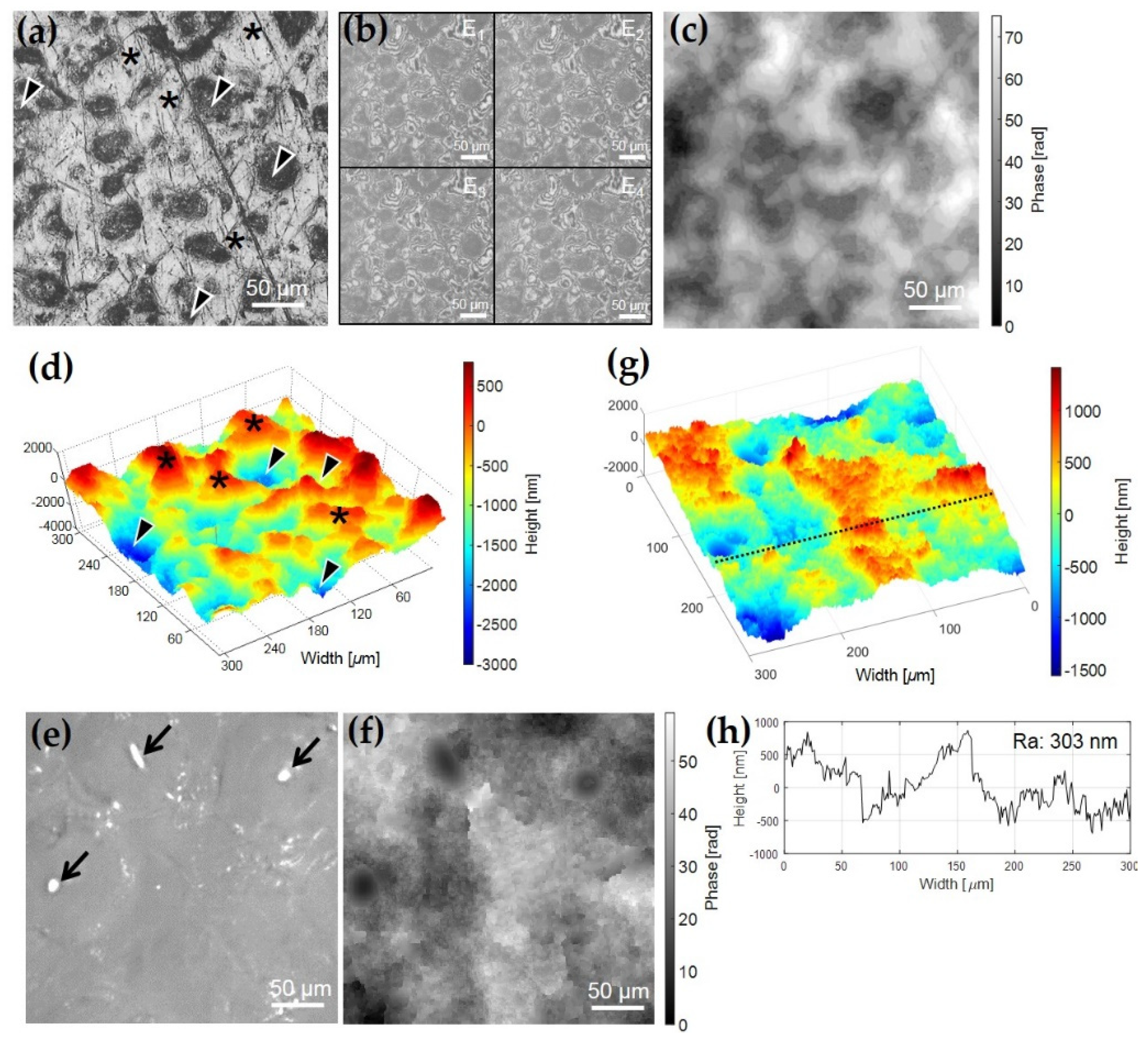In Situ Metrology for Pad Surface Monitoring in CMP Using a Common-Path Phase-Shifting Interferometry: A Feasibility Study
Abstract
Featured Application
Abstract
1. Introduction
2. Materials and Methods
3. Results
3.1. Measurement of System Sensitivity to External Noises
3.2. Validation of System Performance
3.3. CMP Pad Surface Measurements Using System
4. Discussion
5. Conclusions
Supplementary Materials
Author Contributions
Funding
Institutional Review Board Statement
Informed Consent Statement
Data Availability Statement
Acknowledgments
Conflicts of Interest
References
- Moore, G.E. Cramming more components onto integrated circuits. Electronics 1965, 38, 114–117. [Google Scholar] [CrossRef]
- Liau, L.; Muray, A.; Chen, M. Impact of wafer flatness on submicron optical lithography. In Proceedings of the Microlithography Conference, Optical Microlithography VI, Santa Clara, CA, USA, 1 January 1987; Stover, H.L., Ed.; SPIE: Bellingham, WA, USA, 1987. [Google Scholar]
- Nanz, G.; Camiletti, L.E. Modeling of chemical-mechanical polishing: A review. IEEE Trans. Semicond. Manuf. 1995, 8, 382–389. [Google Scholar] [CrossRef]
- Perry, K.A. Chemical mechanical polishing: The impact of a new technology on an industry. In Proceedings of the 1998 Symposium on VLSI Technology Digest of Technical Papers (Cat. No.98CH36216), Honolulu, HI, USA, 9–11 June 1998. [Google Scholar]
- Bastawros, A.; Chandra, A.; Guo, Y.; Yan, B. Pad effects on material-removal rate in chemical-mechanical planarization. J. Electron. Mater. 2002, 31, 1022–1031. [Google Scholar] [CrossRef]
- McGrath, J.; Davis, C. Polishing pad surface characterization in chemical mechanical planarization. J. Mater. Process. Technol. 2004, 153–154, 666–673. [Google Scholar] [CrossRef]
- Yang, J.C.; Oh, D.W.; Kim, H.J.; Kim, T. Investigation on surface hardening of polyurethane pad during chemical mechanical polishing (CMP). J. Electron. Mater. 2010, 39, 338–346. [Google Scholar] [CrossRef]
- Zhao, T.; Yuan, J.; Deng, Q.; Feng, K.; Zhou, Z.; Wang, X. Contrast experiments in dielectrophoresis polishing (DEPP)/chemical mechanical polishing (CMP) of sapphire substrate. Appl. Sci. 2019, 9, 3704. [Google Scholar] [CrossRef]
- Zhuang, Y.; Liao, X.; Borucki, L.J.; Theng, S.; Wei, X.; Ashizawa, T.; Philipossian, A. Effect of pad micro-texture on frictional force, removal rate, and wafer topography during copper CMP process. Electrochem. Soc. Trans. 2010, 27, 599–604. [Google Scholar] [CrossRef]
- Choi, W.J.; Jung, S.P.; Shin, J.G.; Yang, D.; Lee, B.H. Characterization of wet pad surface in chemical mechanical polishing (CMP) process with full-field optical coherence tomography (FF-OCT). Opt. Express 2011, 19, 13343–13350. [Google Scholar] [CrossRef] [PubMed]
- Hamann, G. Optical 3D Surface Measuring Technology: Accurate Profile Reproduction of the Finest Structures Thanks to Piezo Technology and Confocal Technology. Available online: http://onlinelibrary.wiley.com/doi/pdf/10.1002/opph.201500007 (accessed on 14 July 2021).
- Matilla, A.; Mariné, J.; Pérez, J.; Cadevall, C.; Artigas, R. Three-dimensional measurements with a novel technique combination of confocal and focus variation with a simultaneous scan publication. In Proceedings of the SPIE Photonics Europe, Optical Micro- and Nanometrology VI, Brussels, Belgium, 3–7 April 2016; Gorecki, C., Ed.; SPIE: Bellingham, WA, USA, 2016. [Google Scholar]
- Application Note: In-situ Metrology for Pad Surface Monitoring in CMP. Available online: https://www.sensofar.com/wp-content/uploads/2015/07/App-note-S-mart-CMP.pdf (accessed on 14 July 2021).
- Park, J.S.; Chen, Z.; Jung, M.Y.; Kim, C.S. Double common-path interferometer for flexible optical probe of optical coherence tomography. Opt. Express 2012, 20, 1102–1112. [Google Scholar] [CrossRef] [PubMed][Green Version]
- Dubois, A. Phase-map measurements by interferometry with sinusoidal phase modulation and four integrating buckets. J. Opt. Soc. Am. A 2001, 18, 1972–1979. [Google Scholar] [CrossRef] [PubMed]
- Costantini, M. A novel phase unwrapping method based on network programming. IEEE Trans. Geosci. Remote Sens. 1998, 36, 813–821. [Google Scholar] [CrossRef]
- de Lega, X.C.; de Groot, P. Optical topography measurement of patterned wafers. In Proceedings of the Characterization and Metrology for ULSI Technology 2005, Richardson, TX, USA, 15–18 March 2005; Seiler, D.G., Ed.; AIP: College Park, MD, USA, 2005. [Google Scholar]
- Fay, M.F.; Dresel, T. Applications of model-based transparent surface films analysis using coherence-scanning interferometry. Opt. Eng. 2017, 56, 111709. [Google Scholar] [CrossRef]
- Albero, J.; Bargiel, S.; Passilly, N.; Dannberg, P.; Stumpf, M.; Zeitner, U.D.; Rousselot, C.; Gastinger, K.; Gorecki, C. Micromachined array-type Mirau interferometer for parallel inspection of MEMS. J. Micromech. Microeng. 2011, 21, 065005. [Google Scholar] [CrossRef]
- Meng, D.D.; Kim, J.; Kim, C.-J. A degassing plate with hydrophobic bubble capture and distributed venting for microfluidic devices. J. Micromech. Microeng. 2006, 16, 419–424. [Google Scholar] [CrossRef]
- Ngoi, B.K.A.; Venkatakrishnan, K.; Sivakumar, N.R. Phase-shifting interferometry immune to vibration. Appl. Opt. 2001, 40, 3211–3214. [Google Scholar] [CrossRef] [PubMed]




Publisher’s Note: MDPI stays neutral with regard to jurisdictional claims in published maps and institutional affiliations. |
© 2021 by the authors. Licensee MDPI, Basel, Switzerland. This article is an open access article distributed under the terms and conditions of the Creative Commons Attribution (CC BY) license (https://creativecommons.org/licenses/by/4.0/).
Share and Cite
Kim, E.-S.; Choi, W.-J. In Situ Metrology for Pad Surface Monitoring in CMP Using a Common-Path Phase-Shifting Interferometry: A Feasibility Study. Appl. Sci. 2021, 11, 6839. https://doi.org/10.3390/app11156839
Kim E-S, Choi W-J. In Situ Metrology for Pad Surface Monitoring in CMP Using a Common-Path Phase-Shifting Interferometry: A Feasibility Study. Applied Sciences. 2021; 11(15):6839. https://doi.org/10.3390/app11156839
Chicago/Turabian StyleKim, Eun-Soo, and Woo-June Choi. 2021. "In Situ Metrology for Pad Surface Monitoring in CMP Using a Common-Path Phase-Shifting Interferometry: A Feasibility Study" Applied Sciences 11, no. 15: 6839. https://doi.org/10.3390/app11156839
APA StyleKim, E.-S., & Choi, W.-J. (2021). In Situ Metrology for Pad Surface Monitoring in CMP Using a Common-Path Phase-Shifting Interferometry: A Feasibility Study. Applied Sciences, 11(15), 6839. https://doi.org/10.3390/app11156839







